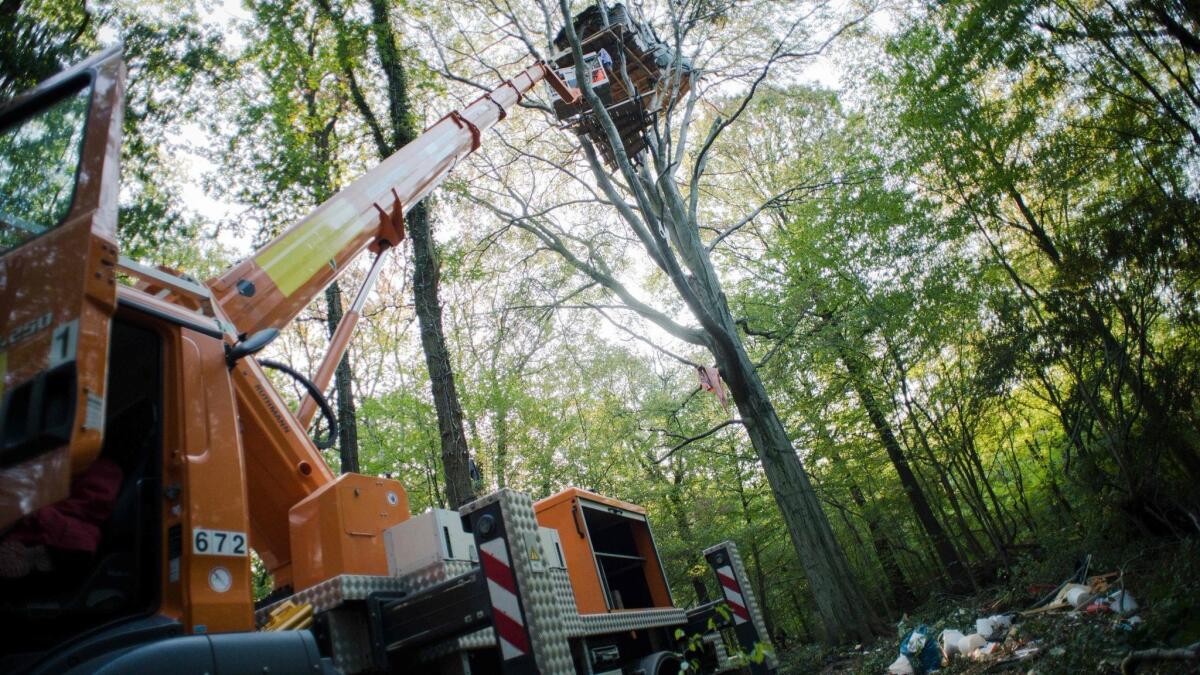Environmentalists and police battle in a 12,000-year-old German forest in fight over coal mining

Reporting from Cologne, Germany — When German riot police began removing environmental protesters from treehouses perched high in a 12,000-year-old forest, they were met with an organic response: buckets of human waste raining down on their helmets and shoulders.
Two weeks later, most of the 150 activists have been removed from their redoubts in the oak and beech trees of Hambach Forest, a few miles west of Cologne. But the struggle over whether the woods should be cleared to make way for an open-pit coal mine has cast a spotlight on Germany’s uneven efforts to meet its decades-old pledges to reduce carbon dioxide emissions.
In keeping with its image as a clean energy leader, Germany promised in 1997 to reduce such emissions 40% by 2020 from the level in 1990. Much of the reduction resulted from unification with communist East Germany, whose heavily polluting industrial base quickly collapsed. Since then, Germany has made little further headway — with the total reduction amounting to 33%.
The Hambach Forest clearing, due to be carried out by a major power company, RWE, has been in the works for years to help meet the energy needs of the world’s fourth-largest economy. But it has met with stiff resistance from environmentalists who say their country is two-faced because it continues to allow the operations of 90 coal-burning power plants that account for nearly 40% of its electricity.
The current protests have attracted widespread media coverage and growing support for the activists — even though some people believe the environmentalists have no right to be on property owned by a utility that long ago won state approval for its tree-clearing mine project.
“There are two main goals: to preserve the forest and to ensure the brown coal lying in the ground beneath stays there instead of being burned for electricity,” said Tobias Muenchmeyer, deputy director of Greenpeace in Germany.
In all, 51 treehouses, many of them connected by ropes about 70 feet in the air, dotted the ancient forest when a force of 400 police officers showed up to remove the 150 demonstrators inside.
It appears, though, that the authorities were taken by surprise by the response.
The canisters of waste hurled out of the blue skies splattered on the black uniforms of the riot police and forced them into a disorderly retreat. Adding to the barrage, some of the 150 activists — males and females ages 17 to 40 — tossed rocks and at least one crude incendiary device, authorities said.
“Coming from those heights, as you can imagine, it dispersed out over a rather large area, hitting quite a few officers,” police spokesman Paul Kemen said. “It’s not only disgusting but inhumane and rather barbarous. It shows an utter lack of respect for human dignity.”
“You have the right to demonstrate,” Kemen added. “You can debate the issue of preserving the forest too. But what they did was just disrespectful.”
As it turns out, the activists’ victory proved short-lived, with authorities bringing in a 120-foot-high crane topped with cherry-picking baskets to remove and charge them with trespassing and disturbing the peace. Of the 51 treehouses, only a dozen had yet to be cleared.
Work was hampered on Thursday when local company officials renting the cranes to the police canceled the contracts because they were appalled by the way the equipment was being used.
The battles, which have taken place mostly behind a police cordon, thrust a spotlight on a struggle pitting those fighting climate change against German industry and its seemingly insatiable energy needs.
While pointing fingers at other heavily polluting countries, Germany, critics say, has turned a blind eye to its support for its own coal-burning utilities — belching out 232 million tons of carbon dioxide a year, more than 25% of the nation’s total output last year.
Germany has only seven nuclear plants remaining and will switch those off by 2020; it also gets nearly 40% of its electricity from renewable sources. About 28,000 jobs nationwide still depend on its remaining coal-burning power plants.
The perilous situation in the treehouses was highlighted Wednesday afternoon when police said a man fell from one of the treehouses and later died from his injuries.
The 27-year-old, identified only by his first name, Steffen, was believed to be a blogger, artist and activist living in the trees who was attempting to take photos of police moving in to clear a treehouse when he fell from a crude rope bridge at a height of 80 feet.
The state government later suspended all further police efforts to clear the remaining treehouses for an indefinite period. “We can’t just go on as if nothing happened,” said a state government official.
Just hours before the accident, one man in a treehouse expressed his fear that the end of the resistance was near.
“We’re losing this fight and the forest will be destroyed,” said the distressed man, who declined to provide his name, in a brief cellphone interview. “It’s irrelevant if it’s legal or not that we’re trespassing. We’re concentrating on what’s legitimate. We say that what RWE is doing is not legitimate. We tried to save it, but we’re losing.”
On Sunday in a nearby village, there was a large demonstration in support of preserving the forest. Police said about 3,500 people participated, while organizers said there were 7,000.
Germans have long had a rather romantic attachment to their forests; some remembering the victory of Germanic tribes over Roman forces in the Teutoburg Forest more than 2,000 years ago.
More recently, police and demonstrators engaged in fierce battles over a cluster of trees outside the train station in Stuttgart that a major construction project was due to destroy.
“There are some powerful images for many Germans when it comes to their forests,” said Thomas Jaeger, a political scientist at Cologne University, noting the Stuttgart fight resulted in the toppling of a conservative state government in 2011.
“Germans see their trees and forests as sturdy, immovable objects that can withstand almost anything,” Jaeger said. “It’s hard to overestimate their attachment to their trees and their forests.”
Kirschbaum is a special correspondent.
UPDATES:
1:40 p.m., Sept. 23: This story was updated with information about a Sunday demonstration.
9:50 a.m.. Sept., 21: This story was updated with more information about the fatal fall, and other details.
This story was originally published at 3 a.m.
More to Read
Sign up for Essential California
The most important California stories and recommendations in your inbox every morning.
You may occasionally receive promotional content from the Los Angeles Times.










